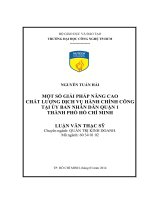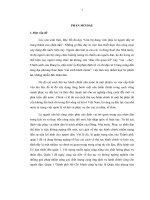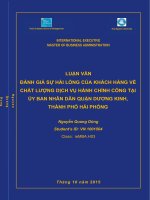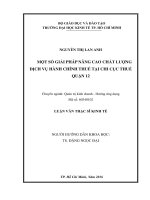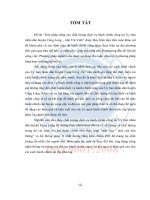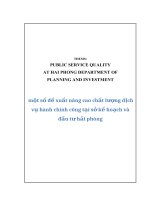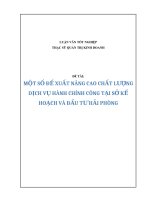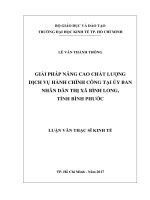một số đề xuất nâng cao chất lượng dịch vụ hành chính công tại sở kế hoạch và đầu tư HAI PHONG eng
Bạn đang xem bản rút gọn của tài liệu. Xem và tải ngay bản đầy đủ của tài liệu tại đây (1.56 MB, 97 trang )
THESIS:
PUBLIC SERVICE QUALITY
AT HAI PHONG DEPARTMENT OF
PLANNING AND INVESTMENT
một số đề xuất nâng cao chất lượng dịch
vụ hành chính công tại sở kế hoạch và
đầu tư hải phòng
DECLARATION
Student: Hoang Anh Tuan
Class : Ie MBA H02
After graduation enternship, I have completed the thesis “Public service
quality at Hai Phong Department of Planning and Investment”. It is the result of
research and practical working process of the public service quality development
activities at Hai Phong Department of Planning and Investment.
I hereby declare that the thesis:
- Do not copy from any other studies without references.
- All data in the study are given permission by the enternship agencies.
If there are any violations, I will take all responsibilities for that.
Hai Phong, ...,
....., 2014
Student
Hoang Anh Tuan
i
ACKNOWLEDMENTS
ii
TABLE OF CONTENTS
DECLARATION.......................................................................................................i
ACKNOWLEDMENTS...........................................................................................ii
TABLE OF CONTENTS........................................................................................iii
LIST OF TABLES...................................................................................................vi
LIST OF FIGURES................................................................................................vii
INTRODUCTION....................................................................................................1
CHAPTER 1: OVERVIEW OF BASIC THEORY OF PUBLIC SERVICES AND
CUSTOMER SATISFACTION.................................................................................5
1.1 Overview of service and service quality..........................................................5
1.1.1 Service and characteristics of service........................................................5
1.1.2 Definitions of service quality, public service quality................................8
1.2 Measuring service quality model...................................................................11
1.2.1 Five gaps service quality model..............................................................11
1.2.2 Measuring service quality: SERVQUAL scale........................................13
1.2.3 The studies applying SERVQUAL and SERVPERF...............................13
1.3 Factors affecting public service quality.........................................................16
1.4 Factors assess service quality, public service quality.....................................18
1.4.1 Factors evaluate service quality..............................................................18
1.4.2 Factors to assess public service quality...................................................20
1.5 Definitions of customer and customer satisfaction; classification of customer
............................................................................................................................. 25
1.5.1 Definitions of customer and customer satisfaction..................................25
1.5.2 Classification of customers.....................................................................26
1.6 Customer demand and customer satisfaction.................................................28
1.6.1 Customer demand...................................................................................28
1.6.2 Customer satisfaction..............................................................................29
1.7 Factors affecting customer satisfaction..........................................................31
1.8 Service quality components affecting customer satisfaction..........................32
1.9 The relationship between service, service quality and customer satisfaction. 33
iii
CHAPTER 2: ANALYZE CURRENT SITUATION OF PUBLIC SERVICES AND
CUSTOMER SATISFACTION AT THE PROCEDURE RECEPTION AND
RESULT RETURN FOR BUSINESS REGISTRATION SECTION - HAI PHONG
DEPARTMENT OF PLANNING AND INVESTMENT........................................35
2.1 Overview of the Procedure Reception and Result Return for Business
Registration Section.............................................................................................35
2.1.1 Introduction about establishment process of the Procedure Reception and
Result Return for Business Registration Section.............................................35
2.1.2 Functions, tasks of the Division of Reception and Return of Business
Registration......................................................................................................38
2.1.3 Results at the Reception and Returning Result for Business Registration
Section of Hai Phong Department of Planning and Investment from 2008 to
2013.................................................................................................................40
2.2 Analysis and assessment of current situation of public service quality at the
Reception and Returning Result for Business Registration Section.....................43
2.2.1 Current situation of public service quality at the Reception and Returning
Result for Business Registration Section.........................................................43
2.2.2 Building model to assess customer satisfaction at the Procedure
Reception and Result Return for Business Registration Section......................45
2.3 Research analysis and results.........................................................................47
2.3.1 Data description......................................................................................47
2.3.2 Reliability analysis..................................................................................52
2.3.3 Factor analysis........................................................................................58
2.3.4 Regression analysis.................................................................................68
CHAPTER 3: SUGGESTIONS TO IMPROVE QUALITY AND EFFICIENCY IN
PUBLIC SERVICE PERFORMANCE TOWARD CUSTOMER SATISFACTION
AT THE RECEPTION OF RECEIVING AND RETURNING RESULT FOR
BUSINESS REGISTRATION SECTION - HAI PHONG DEPARTMENT OF
PLANNING AND INVESTMENT.........................................................................71
iv
3.1 Summary of research findings.......................................................................71
3.2 Policy objectives............................................................................................71
3.3 Solutions to improve service quality and customer satisfaction.....................72
3.3.1 Transparency...........................................................................................73
3.3.2 Procedures..............................................................................................73
3.3.3 Attitude of the officials...........................................................................76
3.3.4 Competency of the officials....................................................................77
3.3.5 Empathy of the officials..........................................................................78
3.3.6 Infrastructures.........................................................................................79
CONCLUSIONS....................................................................................................81
REFERENCES.......................................................................................................83
APPENDIX..............................................................................................................1
v
LIST OF TABLES
Table 1.1: SERVPERF scale....................................................................................15
Table 1.2: Summary of studies on service quality....................................................19
Table 2.3: Results at the Reception and Returning Result for Business Registration
Section of Hai Phong Department of Planning and Investment...............................40
Table 2.4: Reliability statistics of Transparency scale..............................................53
Table 2.5: Reliability statistics of Procedure scale...................................................53
Table 2.6: Reliability statistics of Attitude scale......................................................54
Table 2.7: Reliability statistics of Competency scale...............................................55
Table 2.8: Reliability statistics of Empathy scale.....................................................56
Table 2.9: Reliability statistics of Infrastructure scale.............................................57
Table 2.10: Reliability statistics of Customer satisfaction scale...............................58
Table 2.11: Exploratory factor analysis for transparency scale................................59
Table 2.12: Exploratory factor analysis for procedure scale....................................60
Table 2.13: Exploratory factor analysis for attitude scale........................................61
Table 2.14: Exploratory factor analysis for competency scale.................................63
Table 2.15: Exploratory factor analysis for empathy scale......................................64
Table 2.16: Exploratory factor analysis for Infrastructure scale...............................66
Table 2.17: Exploratory factor analysis for customer satisfaction scale...................67
Table 2.18: Regression analysis summary...............................................................69
vi
LIST OF FIGURES
Figure 1.1: Service quality model of Parasuraman..................................................12
Figure 1.2: Activities of providing public services..................................................21
Figure 2.3: Procedure to direct, receive, process and return results for business
registration...............................................................................................................40
Figure 2.4: Results at the Reception and Returning Result for Business Registration
Section of Hai Phong Department of Planning and Investment...............................41
Figure 2.5: Research model.....................................................................................45
Figure 2.6: Research procedure...............................................................................46
vii
Hoang Anh Tuan – IeMBA – H02
INTRODUCTION
Statement of problem
Continue to simplify administrative procedures in state management sector,
especially improving administrative procedures in fields of real estate, business
registration, investment registration, constructions; and so on strongly attract
attentions from the authorities at all level. This can be considered as not only an
urgent but also a long-term issue to gradually establish a transparent administration
which contributes to promote sustainably social and economic development.
To address this mission, the government has directed ministry, industry, and
local authorities to implement solutions such as reviewing and reducing
inappropriate administrative procedures; simplifying administrative procedures;
applying quality management system under ISO 9000 standards; applying singledoor reception with only one seal; strengthening discipline, administrative penalty;
enhancing professional qualifications for staff; investing equipments and facilities;
applying information technology in addressing administrative procedures, etc.
In the role of a specialized department with advisory function, supporting
Hai Phong People’s Committee to perform management function about planning
and investment, Hai Phong Department of Planning and Investment has actively
implemented mentioned practices with the purpose to create favorable conditions
and the best satisfaction for organization and citizens (refer to customer in
following) coming to make transactions at Hai Phong Department of Planning and
Investment.
Whether public service quality at Hai Phong Department of Planning and
Investment can meet customer need and make customer satisfied is highly
questionable. Moreover, another question is that how to assess public service
quality at Hai Phong Department of Planning and Investment? This is also a
concerned issue by state administrative agencies which supply public services,
especially in the context of international economic integration and rapidly social
and economic development nowadays.
1
Recognizing the importance of promoting administrative procedure reform,
improving public service quality, and creating customer satisfaction; therefore, the
research entitled “Public Service Quality at Hai Phong Department of Planning and
Investment” is necessary for the Department of Planning and Investment in Hai
Phong. Research questions are as following:
1. How is the relationship between public service quality and customer
satisfaction?
2. What factors have impact on customer satisfaction level about public
service quality at Hai Phong Department of Planning and Investment?
3. What are suggestions for improving public service quality and increasing
customer satisfaction at Hai Phong Department of Planning and Investment?
Purpose and specific objectives
Purpose
The purposes of this study are to assess the public service quality based on
opinions of customers making transactions at Hai Phong Department of Planning
and Investment; to study on the relationship and factors affecting customer
satisfaction; to give suggestions and recommendations to improve public service
quality at Hai Phong Department of Planning and Investment.
Specific objectives
Examine fundamentally theoretical issues of service, public service, quality
management, quality management in public service, customer and customer
satisfaction to have an overview on this issue.
Collect and analyze survey data from customers using public services at Hai
Phong Department of Planning and Investment.
Give some suggestions to improve quality and efficiency in public service
performance toward higher customer satisfaction.
Subjects and scope of the study
Subjects of the study
Public service quality, customer satisfaction when using public services at
Hai Phong Department of Planning and Investment, and factors affecting customer
satisfaction about public services performed by Hai Phong Department of Planning
and Investment.
Scope of the study
2
- In terms of space: The thesis focuses on studying public services performed
by Hai Phong Department of Planning and Investment at Reception of receiving and
returning results for Business Registration Section.
- In terms of time: survey time from May 2014 to July 2014
- Participants of the survey: customers who come to make transactions at the
Reception of receiving and returning results for Business Registration Section.
Research methodology
Using synthesis method: reviewing literature; analyzing secondary data;
conducting survey and analyzing collected data.
Outline of the thesis
Title: “Public Service Quality at Hai Phong Department of Planning and
Investment”
Besides table of contents, introduction and list of references, the thesis
consists of three chapters:
Chapter 1: Overview of basic theory of public services and customer
satisfaction.
- Service and characteristics of service
- Definitions of service quality, public service quality, and customer
satisfaction
- Contents of service quality, public service quality and customer satisfaction
- Factors affecting service quality, public service quality and customer
satisfaction
- Factors to assess service quality, public service quality and customer
satisfaction
Chapter 2: Analysis of current situation of public services and customer
satisfaction at the Reception of receiving and returning result for Business
Registration Section
- Overview of the Reception of receiving and returning result for Business
Registration Section
- Analysis and assessment of current situation of public service quality at the
Reception of receiving and returning result for Business Registration Section - Hai
Phong Department of Planning and Investment
- Analysis and assessment of collected data from survey on customer
satisfaction about public service quality at the Reception of receiving and returning
3
result for Business Registration Section - Hai Phong Department of Planning and
Investment
Chapter 3: Suggestions to improve quality and efficiency in public service
performance toward customer satisfaction at the Reception of receiving and
returning result for Business Registration Section - Hai Phong Department of
Planning and Investment
- Some suggestions and recommendations to improve service quality at the
Reception of receiving and returning result for Business Registration Section - Hai
Phong Department of Planning and Investment
4
CHAPTER 1: OVERVIEW OF BASIC THEORY OF PUBLIC
SERVICES AND CUSTOMER SATISFACTION
This chapter aims to introduce generalized theoretical framework for
measuring the citizens’ satisfaction of public service includes the following
sections: Introduction of the concept of public service, service quality, theoretical
framework for measuring the public service quality and customer satisfaction and
the theoretical framework for the application of ISO standards on public service,
ultimately the theoretical models proposed including the factors of pulic service
quality that affect customers’ satisfaction.
1.1 Overview of service and service quality
1.1.1 Service and characteristics of service
1.1.1.1 Service
Service in economics is understood to be the same as commodities but is
immaterial. There are service-products more like tangible products and serviceproducts totally service, but most of the services are in the range between the goods
- services.
Public services are services which are provided by government agencies to
people and organizations living within its jurisdiction based on the law and
regulations. Public services represent the relationship between the state and its
citizens; in this relationship, the citizens do not have the right to choose and must
receive compulsory services by state regulations. In this case, the public services
normally are the documents or procedures that the organizations and people must be
done in administrative procedures.
The public services are implemented by the government agencies through
two basic functions: (1) the management function of the state to every aspect of
economy and society and (2) the administrative function of the state providing
public services for organizations and citizens. In other words, “Public services are
activities that serve as the basic rights and obligations of organizations and citizens
and are performed by the state administrative agencies based on the law and
5
regulations”. However, other than the meanings of the term “public services”
mentioned above, the public services that are provided by Vietnamese government
agencies are a separate category of “public services” in common. These public
services have the following characteristics which are distinct with other types of
public services:
First: The supply of public services is always associated with the jurisdiction
and activities of state administrative agencies - the legal nature of power - in the
implementation of the rights and obligations of organizations and citizens such as
licenses, birth certificates, notaries public, civil status, etc. The administrative
jurisdiction is represented by the public services that the state administrative
agencies supply to address the rights and interests of the citizens. These activities
can not authorize to any other organizations outside the state administrative
agencies to implement and take effect only by the state administrative agencies.
Therefore, the needs to be resolved the administration rights and benefits of the
citizens (customers) are not on their own needs but come from the government
compulsory regulations. The government mandate and encourage the citizens to
carry out these regulations to ensure an order and safe society, and to perform the
management function to every aspects of the society.
Second: The public services represent the management function of the state.
Public services themselves do not belong to the state’s management function, but
they are operated to serve this function. Thus, the legal scientific researchers have
recently raised legal issues surrounding the separation of administrative functions
and management functions in the operation of the state administrative agencies.
Third: The public services are not-for-profit activities and are only charging
fees for the state budget (according to the strict regulations of the authorized state
agencies). The agencies that perform public services are not directly benefit from
this revenue source.
Fourth: All citizens and organizations have equal rights in the receipt and use
of public services as the service subjects of the government. The state has
responsibility and obligation to serve the citizens based on the principles of equity,
ensuring stability, equity and efficiency of social management activities.
6
From the basic characteristics mentioned above, basic types of public
services are identified as follows:
First, supplying authorized licenses such as building permits, digging
permits, parking permits, investment licenses, entry and exit permits, business
registration and practicing certificates, etc.
Second, supplying certificates and certified documents such as qualified
certified practicing; birth certificate, death certificate, marriage certificate; certified
copies and signatures; notarized, etc.
Third, charging fees for the state budget and funds
Fourth, settling complaints and denunciations of citizens and handling
administrative violations.
Products of the administrative services mentioned above arise from many
type of administrative paperwork. They themselves reflect the specific results of the
public services. In order to easily manage and resolve administrative procedures
related administrative public services are classified as above.
On the basis of analysis and comparison of the public services for the
administrative management of the state and the public service in common, it can be
seen that the public services are activities that serve as the basic rights and
obligations of organizations and citizens and are performed by based on the
government’s administrative jurisdiction.
1.1.1.2 Characteristics of service
The features of services are usually depicted in term of four key
characteristics: i) Intangibility, ii) Inseparability, iii) Heterogeneity, and iv) Perish
ability. These characteristics create the main difference of services compared to a
physical product and difficult to measure (Parasuraman, 1985). These
characteristics can be explained as follows:
a. Intangibility. Unlike the tangible manufactured products, services are
intangible. Services are purely performance. Customers can not see, taste, smell,
hear, touch or feel services before buying it. It is seen as a performance rather than
an object (Hoffman and Bateson, 2002). This means that the service is a process
rather than an object, is an expression not a particular item, and is felt rather than
consumed (Wallström, 2002).
7
b. Inseparability. In the service sector, service providing is often done at the
same time with service delivery, as opposed to the products that are produced first
and offered to consumers later. Therefore, the service suppliers are difficult to hide
errors or defects in the service because there is no time gap from production to
consumption like tangible products.
c. Heterogeneity. Services are very difficult to perform in an accurate and
consistent manner over time and often vary depending on suppliers, customers, or
the time and place performance, etc. This characteristic makes it difficult to
standardize the service quality as the manufactured products.
d. Perish ability. Services cannot be stored and consumed later. This means
that service would not exist if it is not “consumed” at a certain specified time. This
also proves that the service provider has the ability to control the vagaries of supply
and demand (Hoffman and Bateson, 2002).
1.1.2 Definitions of service quality, public service quality
1.1.2.1 Definitions of service quality
a) Quality:
The term “Quality” has been used for a long time, and is understood in many
different ways. In Vietnamese ordinary dictionary, quality is the overall
characteristics and basic attributes of an object (thing) and makes it distinguishable
from the others. In ISO 9001:2000 Standard, The quality of something can be
determined by comparing a set of inherent characteristics with a set of requirements.
Quality also has ability to satisfy the needs of the market with the lowest cost
(Kaoru Ishikawa, 1968). Quality is a matter of individual perception. Everyone has
different needs and requirements for products, processes and organizations.
Therefore, their perceptions about the quality are the problem of how and to what
extent their needs are satisfied.
b) Service quality:
Various authors have studied about service quality. According to
Wismiewski, M & Donnelly (2001), service quality is defined in many different
ways depending on the subjects of studies and demonstrates to the extent a service
meets the needs and expectations of customers. According to Zeithaml (1996), the
8
service quality is explained as the customer appreciation for the overall superior and
excellent quality of a service. It is a form of behavior and the consequences of a
comparison between the expectation and awareness of what the customers receive.
Service quality is often considered a prerequisite and is crucial factor in the
competition to create and maintain relationships with clients. The organizations will
create the differentiation paying attention to service quality and gain competitive
advantage in the long term (Moore, 1987). Lehtinen (1982) stated that service
quality must be assessed in two aspects: (1) the service provider and (2) the results
of the service. According to Grongoos (1984), the technical quality related to what
is served, and the skilled quality represented how to serve.
Through the analysis, service quality has following basic characteristics:
- More difficult to assess the quality of services than the tangible goods.
- Perceptions of service quality are the result of the comparison between
customers’ expectations of a specific service and how the service meets those
expectations.
- Customers not only evaluate the outcomes of a particular type of service,
but also to assess its supplying progress.
Besides, the services that are provided by the state administrative agencies to
citizens are associated with the implementation of the state management function.
So that, this kind of service quality is evaluated based on the strict and responsible
enforcement, the attitude of public servants to protected the rights and legitimate
interests of citizens and maintain order, security and social development.
1.1.2.2 Definitions of public service quality
Service quality is an important measure of the operation of state
administrative agencies, and is one of the basic results in operation of these
agencies. However, profit is not the main purpose of these agencies because they
also have to perform other functions such as supporting for growth, adjusting the
pace of growth and orienting of growth (Arawati et al., 2007).
Based on the concepts and terminologies that the research scientists used in
the ISO 9001: 2008 such as quality systems, quality planning, quality control, etc.,
the public service can be understood as the ability to conference with the
requirements of individuals and organizations of public services especially the
9
administrative procedures and paperwork. Criteria for assessing the quality of these
services are diverse, including:
- Create trust for people using the service such as documents are resolved in
time (based on the rate of settling administrative documents and resolving
administrative procedures on time), not lost, and misplaced documents.
- Create favorable environment that is convenient for the transaction with the
supporting tools such as: spacious facilities, air-grab sequence number machine (to
ensure fairness), computers for faster resolving the documents, etc.
- Staffs who have sufficient knowledge and expertise related to the fields in
which they are in charge, along with professional operational skills.
- The attitude of the staffs must be courtesy, respect, do not cause
harassment, troublesome for served citizens.
- Flexible, caring, sharing, and reasonable settlement documents and
procedures for the citizens. There must be a link between people using the service
and staffs resolving service.
- Administrative procedures are simple with reasonably resolved time and are
properly regulated by law.
Issues related to quality and quality criteria providing public services in
accordance with the provisions of law, the provisions of ISO Standards (if
applicable services), namely the commitment rules of administrative agencies;
emphasis on regulatory requirements; customer driven by exploration of customer
satisfaction; correction, prevention and continuously improvement of quality
system, etc. Therefore, the administrative activities in accordance with the law, the
rules, the procedures prescribed by law, combining with the logical organization of
labor in the workplace can achieve effective quality and meeting the requirements
of the citizens.
Nowadays, most countries are focusing on improving the quality of public
services, due to the democratic society’s considering: to meet the needs of the
citizens is the first and important duty of government – the higher the quality of
services for people, the higher democracy. The initial assessment of the citizens for
the government is in the quality of services provided by public agencies. The
relationship between the citizens and the state administrative agencies are pulled
10
closer together with the trend of improving the quality of public services. The
advanced technology enables people to express their needs to the society. People
with higher levels of education raised higher requirements for a democratic society
with better transparency and more effective state administration.
1.2 Measuring service quality model
1.2.1 Five gaps service quality model
Parasuraman et al. (1985) are the pioneers of making specific and detail
studies on service quality in marketing. These researchers proposed a five GAP
model of service quality.
Gap 1: is the difference between consumers’ expectation and management’s
perceptions of those expectations. For example, when customers do not know about
the service, they may have strange expectations which may cause significant
different from management’s perceptions.
Gap 2: is the difference between management’s perceptions of consumer’s
expectations and service quality specifications. This gap results from constraints
and obstacles service providers have to face when they try to convert their
perceptions of customers’ expectations into quality specifications to meet
customers’ expectations. These specifications will become marketing information to
customers.
Gap 3: is the difference between service quality specifications and service
actually delivered i.e. the service performance gap. This gap refers to the case when
employees deliver service for customers but it is not meet the defined criteria. The
role of front line staff is very important in creating quality services.
Gap 4: is the difference between service delivery and the information
customer received about service delivery. This information may make increase in
expectations but also make decrease in perceived quality when customers do not
received what service providers committed.
Gap 5: is the difference between consumer’s expectation and perceived
service. Parasuraman et al. (1985) stated that service quality is Gap 5. This gap
depends on the above 4 Gaps.
11
Words of mouth
Personal
Past
communication
needs
experience
Expected service
5
Perceived service
CUSTOMER
MARKETER
Service delivery
(including pre and post
4
External
communicatio
contacts)
ns to the
customer
3
1
Translation of perceptions into
service quality specifications
2
Perceptions (of management)
about the customer
expectations
Figure 1.1: Service quality
model of Parasuraman
Source: Parasuraman et al. (1985)
Parasuraman stated that service quality is a function of Gap 5. Gap 5 depends
on the four previous gaps, namely Gap 1, Gap 2, Gap 3, and Gap 4. Therefore, in
order to to increase service quality, servive managers should attempt to shorten this
gap. Service quality model, in this study, can be illustrated as follows:
CLDV = F{KC_5 = f(KC_1, KC_2, KC_3, KC_4)}
Where: CLDV is service quality
KC_1, KC_2, KC_3, and KC_4 are Gap 1, Gap 2, Gap 3, and Gap 4,
respectively.
12
1.2.2 Measuring service quality: SERVQUAL scale
Service quality model of Parasuraman et al. (1988) can be considered as a
comprehensive picture of service quality. However, this model is more conceptual
and needs a series of studies to test this measuring scale. One of the most important
studies is measuring customers’ perceived service quality.
Parasuraman et al. (1988) have developed and tested the scale including 5
components of service quality. Finally, SERVQUAL scale consists of 21 observed
variables (Appendix 3) to measure 5 components of service quality, namely:
(1) – Reliability: refers to ability to perform service dependably and
accurately right at the first time.
(2) – Responsiveness: refers to willingness and ready to provide services to
customers.
(3) – Competence: refers knowledge and skills of employees to perform
service. These mentioned knowledge and skills are very important for employees
who directly communicate with customers, provide service, and affect the ability to
capture relevant information needed for serving customers.
(4) – Empathy: refers to caring and attention towards each individual
customer.
(5) – Tangibles: refers to appearance of personnel and other physical
facilities and equipment for providing services.
The five Gap service quality model and SERVQUAl scale cover almost
specific attributes of service quality. Parasuraman et al. (1991, 1993) confirmed that
SERVQUAL is a comprehensive scale measuring service quality, with reasonable
reliability and validity, and can be applied in different service types. However, each
different service type has its own characteristics, so there may be some
modifications for the scale depending on specific type and market.
1.2.3 The studies applying SERVQUAL and SERVPERF
After many previous studies, SERVQUAL has been accepted as a valid scale
in theory and practice. However, there is still many debated, criticized and
questionable issues about this scale especially in terms of the generality and the
accuracy. One more thing is that the SERVQUAL measurement procedure is quite
13
complicated. Therefore, there is a modification of SERVQUAL is SERVPERF
scale.
This scale was introduced by Cronin & Taylor (1992, cited in Thongssamak,
2001), defining service quality by measuring only perceived quality of service
(instead of measuring both perception and expectations as SERVQUAL). This
means, according to SERVPERF:
Service Quality = Level of perceived quality
The authors stated that service quality is best reflected by perceived quality,
neither including quality expectations nor assessing the weight of each components.
It is notice that to original from SERVQUAL scale, components and observed
variables of this SERVPERF scale are the same as in SERVQUAL. This
measurement model is called Perception Model.
SERVPERF model of Cronin & Taylor is used to evaluate the quality of
service, including 5 specific factors:
14
Table 1.1: SERVPERF scale
Reliability
1. When company X has promised to do something on a specific time period, the
company will perform.
2 When you has problems, company X expressed sincere interest in solving
problems.
3 Company X performed services right at the first time.
4 Company X provides services exactly as their promised time.
5 Company X notify to customers when their service will be done.
Responsiveness
6 Employees of company X serves you on time.
7 Employees of company X inform you exactly when services will be implemented
8 Employees of company X are always willing to help you.
9 Employees of company X is never too busy to response to your requirements
Assurance
10 Employees of company X can create trust towards the company for you.
11 You feel safe when making transactions with company X
12 Employees of company X are always polite and courteous with you.
13 Employees of company X have knowledge to answer your questions.
Empathy
14 Company X has expressed attentions and cares to each individual customer.
15 Company X has employees who expressed attentions and cares to each
individual customer.
16 Company X expressed special care customers’ concerns.
17 Employees of company X can understand your special needs.
18 Company X has a convenient working time to you.
Tangibles
19 Company X has modern facilities and equipments.
20 Facilities of the company X looks very appealing.
21 Employees of company X have neat and beautiful appearance.
22 The physical facilities supporting serving services in company X looks very
appealing.
(Source: Measuring Service Quality with SERVPERF)
15
1.3 Factors affecting public service quality
Through synthesis of previous research on service quality and customer
satisfaction, this study examines several traditional scales as above. However, the
differences in fields, regions, political - economic – cultural characteristics,
perceptions of citizens lead to the difference in way to assess service quality and
customer satisfaction.
This research aimed towards respondents who are using public services
applied ISO standards at the Department of Planning and Investment of Hai Phong.
As an economic and political center of Vietnam, with relatively high literacy levels,
Hai Phong’s citizens obey to the law, state regulations as well as aware of values
and factors affecting customer satisfaction. The study suggests that public service
quality can be affected by following components:
a) Reliability is customer expectations about implementation of the
commitments made by state administrative agencies for them in the process of
performing public services. Based on previous studies, combining the principles of
applied ISO standards, the authors used qualitative methods to develop the factor
"Reliability" includes the following criteria:
- The transparency of administrative procedures.
- Records with no errors or loss.
- Records do not miss deadlines.
- Being reliable place for customers when they contact to resolve the
administrative procedures.
b) Infrastructures supporting services includes factors such as providing
service area, equipments, tools and other technical facilities ...; especially
equipments in the reception area - where people come to contact with front staff that
represents for the administrative agencies. Based on previous research combining
with the principles of ISO standards, the authors used qualitative methods to build
factor "Infrastructures" including the following criteria:
- Airy, clean and pacious rooms.
- Comfortable facilities such as air conditioning, desk, chair ...
- Equipments supporting services are relatively modern (automatic
numbering, computers, and computers for records lookup ...)
- The layout of the area for receiving, processing and returning results.
16
- The publish of administrative procedures and forms.
c). Staffs’ competency, including the skills and professional knowledge to
accomplish the assigned tasks. This is a very important element which reflects the
quality of the public services. Based on previous research combining with the
principles of ISO standards, the authors used qualitative methods to build factor
"Competency of staffs" including the following criteria:
- Communication skills.
- Knowledge and skills in handling works.
- Proficiency in professional tasks.
- To reasonably solve the problems of customers.
- Resolving complaints of customers quickly and reasonably.
d) Regarding to attitude of serving a service, it is important for public
servants to listen, be patient, speak clearly, have friendly attitude, and handle work
on time. Based on previous research combining with the principles of ISO
standards, the authors used qualitative methods to build factor "Attitude of staffs"
including the following criteria:
- The attitude when receiving, processing and returning the results.
- Attitude when answering people's questions.
- The inconvenience for people when processing records.
- The fair treatment in all administrative services transactions.
- Being high responsible for customers’ records.
e). Empathy refers employees’ attention to customers. This is the
fundamental requirement of the organization which expresses commitment to
dedicatedly serve the people through finding the right solution for every situations
to solve customers’ requirements. Based on previous research combining with the
principles of ISO standards, the authors used qualitative methods to build factor
"Empathy" including the following criteria:
- Customer can contact with staffs who are processing their records.
- Handling records flexibility and promptly.
- The attention of the officers to reasonable requests of the people.
- Staffs easily to understand the customers’ requirements.
f). Administrative procedures, including records required when submitted,
processing the records, the period of contact directly between staffs and customers.
This is mandatory principles of ISO standards in which procedures must be
improved in the process of applying. It is also a objective demand from the fact that
17
